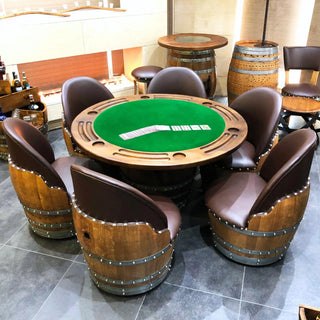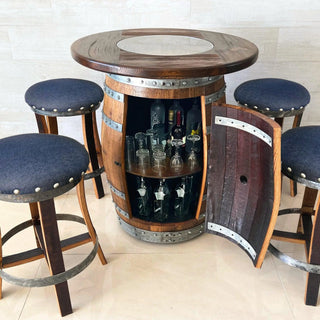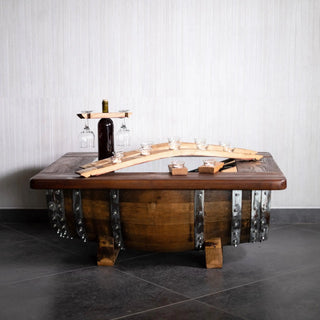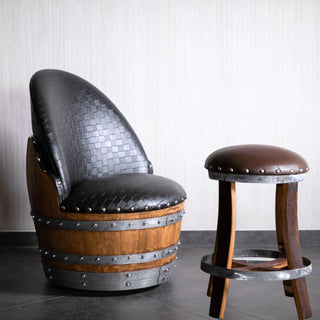How to Refinish and Restore Barrel Seating Over Time
There’s something deeply rewarding about restoring a piece of barrel furniture — the kind of project that makes your hands smell like oak and beeswax for the rest of the day, and your heart just a little fuller.
If you’ve ever run your hand over an old barrel chair or oak stool, you know that feeling — the warmth, the texture, the tiny dents that each tell a story. Maybe it sat by your home bar for years, collecting memories from dinner parties and late-night chats. Or maybe it’s a piece you inherited, its surface now a little faded, a little dry, but still solid as ever.
That’s the beautiful thing about oak furniture: it lasts. And with a bit of care — the kind you can easily do on a Saturday afternoon with some sandpaper and a cup of coffee — it’ll look better than ever.
Today, I’ll show you how to bring your barrel seating back to life — not by stripping away its history, but by revealing the beauty that’s been hiding beneath a layer of time.
Why Barrel Seating Ages So Beautifully
Here’s something I learned early on: oak doesn’t really “wear out.” It just changes. It gets deeper, warmer, softer around the edges — kind of like people do.
The barrel furniture we love — whether it’s a Captain Barrel Chair, a Wine Barrel Pub Stool, or a Hydraulic Oak Bar Stool — starts its life doing something completely different. It spends years in a dim cellar somewhere, soaking up wine or whiskey, expanding and contracting with the seasons, learning patience.
By the time that barrel is reclaimed and reshaped into furniture, it’s not just wood anymore. It’s experience.
That’s why when your stool starts to look a little dry or faded, it’s not a flaw — it’s an invitation. The wood’s just asking for a little attention, the same way you oil a cutting board or wax a pair of boots you love.
When to Know It’s Time to Refinish
You’ll feel it before you see it.
You’ll sit down one morning, run your hand along the armrest, and think, huh, that feels a bit rougher than usual. Or maybe the light hits it differently, and you notice the finish looks dull instead of glowing.
That’s your cue.
Here are a few signs it’s time to give your barrel chair or stool a refresh:
- The wood feels dry or grainy instead of smooth.
- Water doesn’t bead up anymore when spilled.
- The color has dulled or faded unevenly.
- Small scratches or rough patches are starting to appear.
When that happens, don’t panic — it’s actually one of my favorite excuses to slow down, put on some music, and spend a few quiet hours bringing something beautiful back to life.
My First Barrel Chair Restoration (and What It Taught Me)
The first barrel chair I ever refinished was a hand-me-down from my grandfather. He kept it by his bar — the one with the old neon clock and bottles that had probably been there longer than me.
When I inherited it, the chair looked… tired. The finish had gone matte, the seat was rough, and there were water rings from countless whiskey glasses. But when I sat in it, I felt something. It was solid. Real. I could see the grain beneath the wear, begging to shine again.
I’ll be honest — I didn’t know what I was doing at first. I started with cheap sandpaper and too much enthusiasm. But as I worked, the oak started revealing these deep honey and caramel tones I didn’t even know were there. I wiped it down with a little Danish oil, and the moment that light hit it — wow. It looked alive again.
That’s when I understood something: restoring wood isn’t about perfection. It’s about connection.
The Step-by-Step Process (No Fancy Workshop Needed)
You don’t need a garage full of tools or years of woodworking experience for this. Just a bit of patience, some good light, and maybe a favorite playlist.
1. Clean It Gently
Start by wiping the stool or chair down with a soft cloth and a bit of mild soap mixed with warm water. You’re just removing surface dust and oils — don’t soak it. Oak doesn’t like long baths.
If you find sticky patches or old polish residue, a light vinegar-and-water mix does the trick.
Then, let it dry completely.
2. Sand Just Enough
This part’s almost meditative. Grab a piece of fine sandpaper — 220-grit works great — and move with the grain, not against it.
You’re not trying to strip the whole thing down. Just buff away the tired surface and smooth out small imperfections. If it’s curved (and most barrel furniture is), wrap the sandpaper around a sponge or soft pad to follow the shape.
When you start to see the lighter oak peek through, that’s your sign to stop. Wipe off the dust, step back, and admire what’s underneath.
3. Feed the Wood (It’s Thirsty!)
Here’s where the magic happens.
After sanding, the oak’s pores are open and ready to drink. Choose your “meal”:
- Boiled linseed oil for a deep, warm glow.
- Danish oil for a subtle satin finish.
- Beeswax polish for a soft, natural touch.
Personally, I love using a mix of linseed oil and beeswax — it smells incredible and makes the wood gleam without looking artificial.
Rub it in slowly with a soft cloth, working it in circles. You’ll literally watch the color come alive beneath your hands. Let it sit for a few minutes, then buff off the excess.
If you want to go the extra mile, apply a second coat after it dries overnight.
4. Optional: Seal and Protect
If your chair lives in a busy kitchen or bar area, you can seal it with a light matte polyurethane or a hard wax oil for extra protection.
Thin coats, long drying times, and a little patience — that’s the key. The result? A finish that looks professional but still feels natural to the touch.
5. Don’t Forget the Upholstery
If your stool or chair has fabric or leather, give it a little love too.
For leather, use a conditioner (I swear by the ones with natural oils). For fabric, a gentle fabric cleaner or foam spray is enough.
And if your stool has a swivel or hydraulic base, check for loose screws and add a drop of lubricant — they’ll thank you with years of quiet, smooth turns.
A Few Maintenance Habits That Make a Huge Difference
Here’s what I do to keep my barrel chairs looking fresh all year:
- Dust them weekly — the oils from your hands will do the rest.
- Keep them out of direct sunlight (oak tans just like skin).
- Oil or wax once or twice a year — it takes 10 minutes, tops.
- Use coasters (seriously, this one hurts to learn the hard way).
Oak is forgiving. It doesn’t demand perfection — it just appreciates consistency.
What Restoration Teaches You About Oak (and About Life)
Here’s the part they don’t tell you: refinishing barrel furniture is therapeutic.
It’s quiet work. You see progress in real time. And you realize — like a good relationship or a fine wine — beauty doesn’t fade with age. It deepens.
Every scratch, every faded patch, every mark tells a story. When you restore a barrel stool or chair, you’re not erasing time — you’re collaborating with it.
That’s what makes Oak Wood Wine Barrels furniture so special. Every piece already comes with a past, and you get to decide its future.
Why Oak Wood Wine Barrels Pieces Are Worth Restoring
When I first bought from Oak Wood Wine Barrels, I remember thinking, This feels different. The wood wasn’t just “used” — it was seasoned.
You could see it in the grain, smell it in the air — that deep, oaky scent that lingers like an old story. These pieces are built to outlive trends, fast furniture, and probably a few of us, too.
So when the time comes to refinish one, it doesn’t feel like work. It feels like paying respect to craftsmanship.
You’re not fixing something that’s broken — you’re carrying it forward.
Our Links
Other Resources to Check Out!
American Hardwood Information Center – Caring for Oak Furniture
Fine Woodworking – Restoring Oak Furniture
This Old House – How to Refinish Wood Furniture
Disclaimer
Before you break out the sandpaper, just a small reminder — this guide is based on personal experience and a deep love for woodwork, not a rulebook. Every piece of barrel furniture from Oak Wood Wine Barrels is unique, handcrafted from reclaimed oak with its own history, grain, and personality.
The tips here are meant to help you connect with your furniture, not make it factory-perfect. Always test finishes on a small area first, and if your piece is rare, antique, or heavily sentimental, consider chatting with a professional restorer before you start.
Finishes, oils, and materials mentioned here can evolve as we refine our craft — but one thing never changes: our belief that real oak, real craftsmanship, and real care will always stand the test of time.
So take your time. Enjoy the process. And when you’re done, sit back on that beautifully restored stool, run your hand along the smooth oak, and appreciate that you didn’t just refinish furniture — you revived a story.
#oakwoodwinebarrels #winebarrelfurniture #whiskeybarrelfurniture




